2021 was a year that many people are excited to put behind them. From the impact of COVID-19 to global supply chain shortages impacting businesses and consumers alike, the world seems ready for a new change. As we welcome this new year, we pondered some of the changes, trends and impacts we can expect to come in 2022. We’ve examined several factors and conducted some unique research to identify what may impact markets globally. Here is a look into some key predictions for the year ahead.
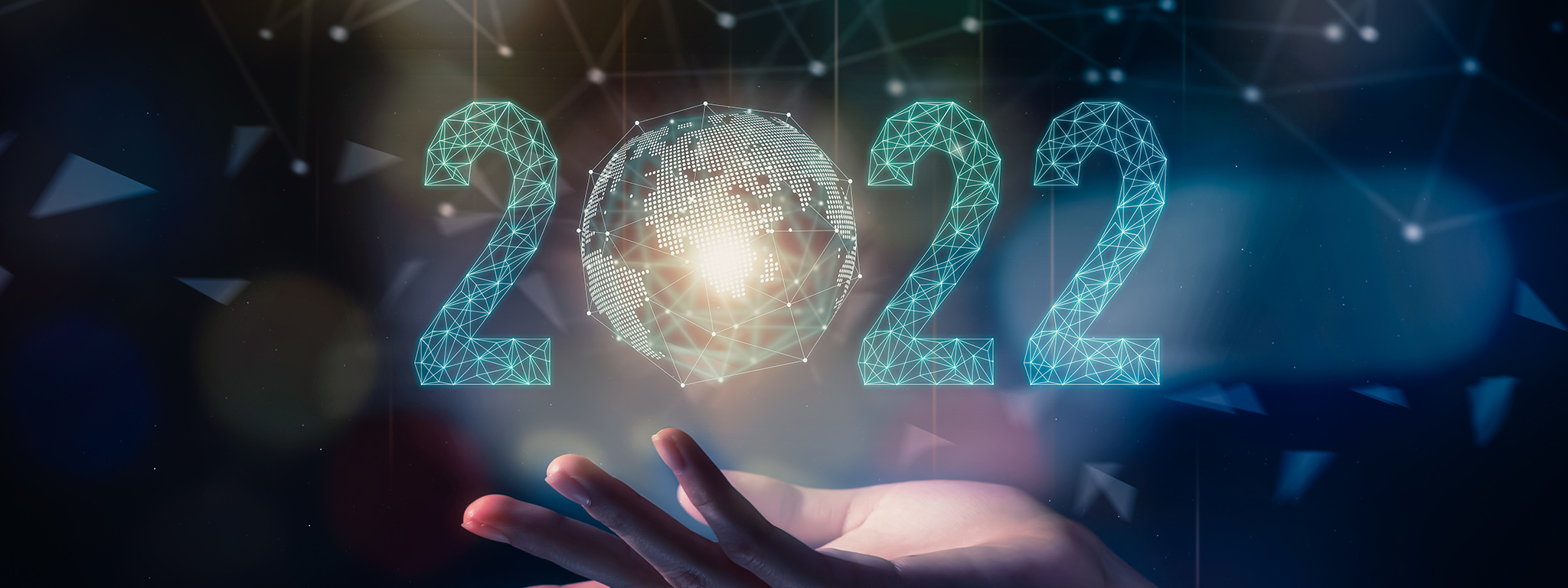
3 Predictions for the Data Center and Enterprise IT in 2022

1. Global chip shortages are going to make organizations rethink their upgrades
The simple truth is that the supply chain issues for delivering international goods isn’t slowing down. From container ships getting into harbors, to trucks transporting goods and raw materials from the docks, the supply-chain delivery issues are having a wide-spread impact. For most of the technology market, that means an impact to chip availability and manufacturing. Thus, tech refreshes aren’t going to happen as fast as processor manufacturers would like. The global shortage is going to cause delays in things like GPUs, memory, select storage and various other components.
Data centers may see the hardest hit if they’re looking to maintain SLAs through hardware upgrades. Due to the lack of available product, there are two options for upgrades: either pay through the nose for just-in-time inventory and have it shipped via air; or increase a dependence on local contract manufacturing to create products for technical specifications. Both of these options are substantial investments, likely only considered by hyperscalers, but they can circumvent the supply-chain bottleneck for off-the-shelf product availability.
However, one bright spot has been in NAND. Because of the supply currently available for flash storage and memory manufacturers, the best upgrade option will likely be for data center managers to get more out of their existing stack. This includes upgrading memory, enhancements to flash storage (either NVMe or SATA) and improving bandwidth allocations through overprovisioning.
2. Cybersecurity concerns will drive new technology purchasing requirements
If we’ve learned anything from SolarWinds, Kaseya or any of the recent ransomware attacks: It's not if, but when you’ll get breached. Security has become one of the leading factors in IT purchasing, as more organizations look to minimize risk and mitigate vulnerabilities. As a result of the pandemic, security teams are facing an ever-growing attack surface with a hybrid workforce. Tools like multi-factor authentication, VPN access and encrypted cloud-based storage are now mandatory for several regulated industries, and their use is becoming standard for many IT organizations.

The question begging most IT and security organizations now: Is the cost of implementing redundant and encrypted stacks worth more than the cost of a breach and its remediation?
The most recent data breaches and hacks show that the cost of rebuilding can be astronomical for not only replacing corrupted or breached infrastructure, but also for business continuity interruptions or any fines associated with customer data leakage. Accordingly, more IT and data center managers will equally rely on encrypted drives, while also implementing complex redundancy strategies.

3. Content explosion is going to put a strain on Cloud storage
Today’s 5G infrastructure is making content easier for consumers to watch video, create content and share it across multiple social platforms and websites. And, given the explosion of content creation over the past few years, there’s no sign of it slowing down. In fact, a recent Cisco estimate states that live video and content creation will grow 15-fold by the end of 2022.
But, with the explosion of viewership, one of the hardest feats is keeping up with the storage demand from consumer apps. Services like TikTok are not only booming with popularity, but their model of allowing viewers to become content creators themselves, adding reactions or other iterations can put a strain on storage paradigms.
For example, a standard 1 minute mobile might only consume 100-200MB of storage. But if that video becomes a content launch-point (e.g. popular dance, music video, or reaction video), there could be anywhere from 40-4,000,000 different versions depending on popularity. What started as 100MB of storage could quickly become 400TB if insanely viral.
Granted, not all videos live forever, and some of the applications may only maintain content for a set period of time, but the elastic nature of video creation services requires that data centers allocate for dynamic growth while also maintaining low latency for playback and seamless user experiences.
While the future of our industry contains many uncertainties, it doesn’t take a crystal ball to see where things are headed. Now is the time for businesses to re-examine goals and needs to put their best foot forward in 2022.
#KingstonIsWithYou
Was this helpful?
Related Videos
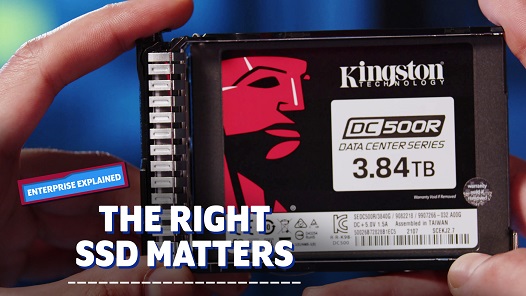
The Right Solid-State Drive (SSD) Matters
Choosing the right SSD is important since not all SSDs are alike. When it comes to data centers, choosing an SSD with the right performance consistency with low latencies that’s specifically built for enterprise and data center workloads is key for consistent and reliable performance.
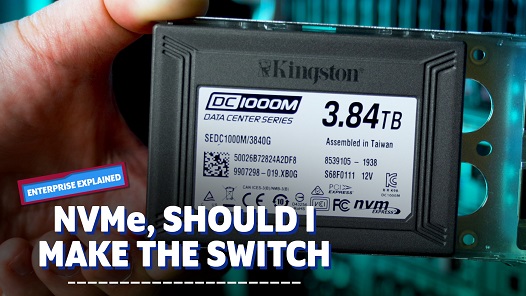
Enterprise Explained: Switch to NVMe?
With the rise of data, need of edge computing and edge networks data center upgrades with NVMe SSDs enable more possibilities than before.
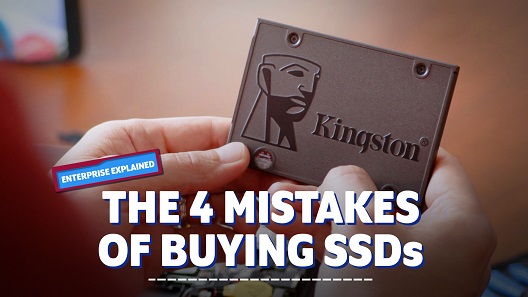
The 4 Mistakes of Buying SSDs for Businesses
SSDs are all alike, right? You plug it in and instantly have all of that Flash Memory available for your workload? Right? If you answered yes, then you’ve probably fallen to one of the 4 biggest mistakes you could make when selecting your SSD.

Rip and Replace vs Predictability: Why SSDs with Predictable Latency Matters
Some enterprises still make use of client SSDs to handle high-intensity server tasks, then rip & replace them when they fail to maintain the required standard of performance. Learn why that’s a false economy and how enterprise-level drives can increase organizational efficiency.
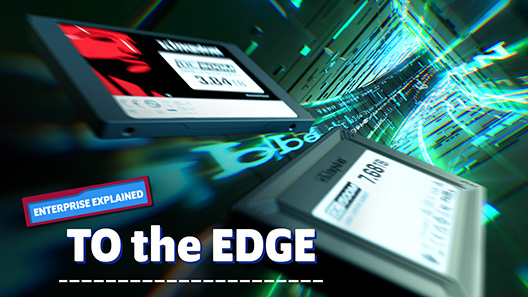
How Storage at the Edge will Power 5G
Is the world ready for 5G? While apps, devices, and more claim 5G-readiness, networks are scrambling. True 5G depends on edge computing: data being closer to customers.
Related Products
No products match your current filter selection. Try adjusting your filters to explore more options.
Related Articles
-

The Difference Between Enterprise & Client SSD
The differences between SSD classes lies in two components; the processor and the NAND memory.
-

Understanding a New Generation of DDR5 Memory Modules: CUDIMM, CSODIMM, CAMM2, and MRDIMM
Learn how innovative memory solutions are transforming laptops, desktops, and data centers.
-
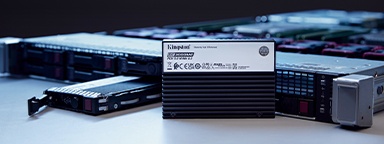
Optimize Data Center Storage with PCIe Gen5 SSDs for AI and Big Data
Explore how SSDs are transforming data centers with advanced technology and performance.
-

Mission Digital Enhances Their Workflows with DC600M SSDs
Learn how Kingston SSDs transformed Mission Digital’s workflow with speed & capacity.
-
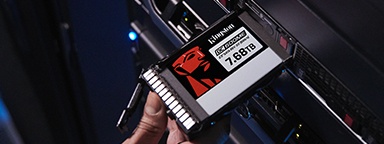
The Importance of SSDs in Data Centers – Expert Insights
Join Simon Bestman to explore SSD benefits over HDDs and the latest storage trends.
-

Why a Home NAS Should be for Everyone
Reasons why a NAS would benefit your home or small office setup.
-

Building Trust Through Performance: Kingston’s Enterprise Solutions Elevate System Integrators
System Integrators in India grew their business and reputation using Kingston’s reliable products.
-

How to Choose the Right Drive For Your Data
Here is a list of USB security features to consider for data protection.
-

The 3-2-1 Data Backup Method: Your Best Defense Against Ransomware Attacks
Learn what the 3-2-1 data backup method is and why it is your best defense against ransomware.
-

The Evolution and Challenges of Data Centers – Expert Insights
Simon Besteman explains the current and future challenges for data centers.
-

The Evolution of Memory Technology – eBook
Explore DRAM technology’s evolution and gain insights into future trends in our eBook.
-
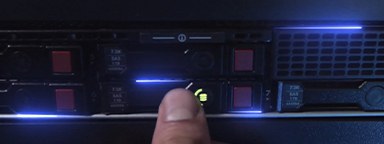
Understanding SSD Endurance: TBW and DWPD
Learn how Terabytes Written and Drive Writes Per Day are defined, and their differences.
-
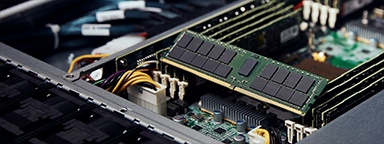
How to Choose Server Memory
We explore the different types of memory & how to make the right choice for your server.
-
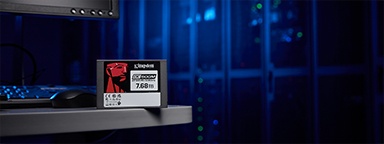
Revolutionizing Data Center Efficiency with VMWare vSAN and DC600M
Read the whitepaper to learn how DC600M helps vSAN demand performance and efficiency.
-

Unlocking the Secrets of Kingston’s DRAM Module Testing
Kingston sets industry standards with unwavering commitment to quality and reliability.
-

How do Kingston SSDs & QNAP NAS power the DCP Workflow for Digital Theaters?
Kingston and QNAP have improved the efficiency of digital theaters with their hardware.
-

Find the Best SSD for Your Data Center
Questions to ask when seeking the right SSD for your organization’s data center.
-

How Many Drive Writes Per Day (DWPD) Do You Actually Need?
Here are some key points to help you better balance price, performance, and longevity.
-

Memory and Storage Unleashed: Fueling Creativity in Entertainment
We explore the how media organizations can speed up workflows through storage and memory.
-

2024: Technology Experts' Predictions
2023 has been a year full of challenges and innovations. But what will 2024 bring?
-
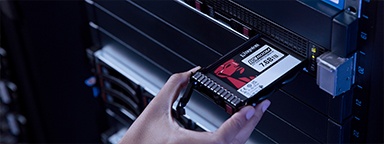
Kingston DC600M Data Center SSD: Now VMware ESXi and vSAN Compatible
Elevate your data center with Kingston's VMware-compatible DC600M enterprise SSDs.
-

Enhancing Content Creator’s Workflow with Kingston SSDs and Memory
Kingston's server SSD and memory transformed Android Basha's production workflow.
-

Performance Photographer Ralph Larmann in the Digital Darkroom
Kingston storage solutions help improve performance photographer Ralph Larmann’s workflow.
-

How Did Kingston SSDs Help DASH Pictures Transform On-location and Post-production Workflows?
DASH Pictures enhances their media production efficiency with Kingston SSDs.
-
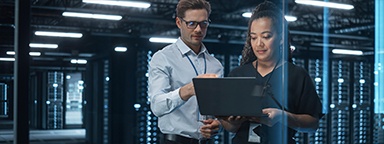
More for Less: Why Is Upgrading Important in Today's Economic Climate?
Discover why upgrading your technology in this economy matters more than ever.
-
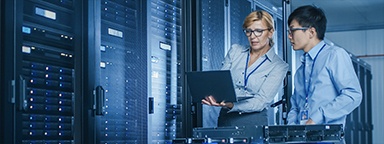
Unlocking the Power: 5 Reasons for Using Data Center SSDs
Server SSDs have higher endurance, better reliability, and improved performance over client SSDs.
-
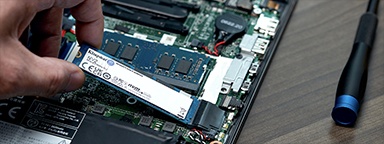
Extend the Life of Your IT: Upgrade Vs. Replace
We explore the benefits of upgrading vs. replacing, and how organizations can succeed.
-
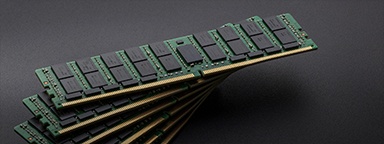
Upgrading Server Hardware vs. Buying the Latest Platform
Assess your existing server hardware to extend its lifespan and maximize your investment.
-

NVMe Is the Silent IT Revolution—What Is It, and Why Should You Adopt It?
Learn about NVMe and why choosing it is beneficial to your organization’s infrastructure.
-
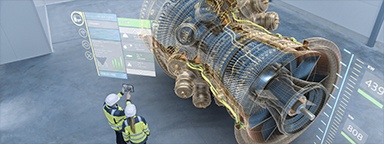
The Rise of the Digital Twin: The Secret Weapon to Next-Level Operations
We discuss the journey of digital twin technology, exploring real-world examples for success.
-
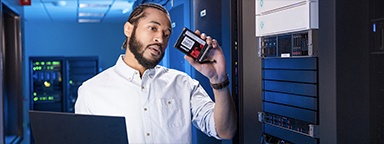
SDS vs. Hardware RAID vs. Software RAID: What Is the Future?
In this whitepaper, we explain the benefits of SDS vs. its HW and SW RAID counterparts.
-
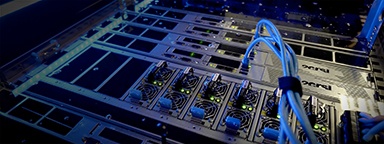
Kingston and 2CRSi Solve Data Center Energy Consumption Challenges
In this video, we explain how Kingston and 2CRSi work together to solve data center challenges.
-
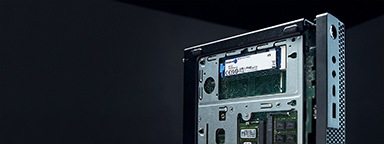
Kingston Memory and SSD Meet Integrator APLIGO GmbH's Strict Requirements
Learn why APLIGO chose Kingston SSD and memory to support their system integration business.
-

Evaluating Storage Products for Your Enterprise Needs
Choosing storage products for your enterprise is a complex process. Kingston offers our expertise.
-

Optimizing Storage in a Creative World
Learn how Kingston and QNAP solutions help optimize content creation.
-

Kingston Memory and Storage Supporting the Needs of a Leading Hosting Provider
Learn how Kingston supported a leading hosting provider with optimal configuration.
-

Build resilient, responsive databases with Kingston’s DC1500M Enterprise NVMe SSDs
Kingston examines how its DC1500M Enterprise NVMe SSD affects workloads and compares to competitors.
-

SSDs: The Changing Face of Data Storage eBook
In this eBook, we speak with experts about the journey of data storage, and what the future holds.
-

SSDs and RAM power every step of the streaming media and entertainment pipeline
From shooting, to post-production, to encoding, to distribution at data centres, SSDs and RAM are powering the world of OTT Media & Entertainment (M&E) video and audio streaming.
-

Top 12 Tips SMEs Can Take to Enhance Cybersecurity
We explore the top 12 tips small and medium size enterprises can take to enhance cybersecurity.
-

What Is Driving the Growth of Data Centers?
This infographic is about the different types of data centers, the myths, and Kingston's DC solutions.
-

2022: Technology Expert Predictions
2021 has been a year full of challenges and innovations. But what will 2022 bring?
-

Digital Transformation: Sustaining Success in a New Business Era
Read our eBook, about the rise of digital transformation and what the future holds.
-

Sustained Commitment Required for Cybersecurity
Bill Mew shares his thoughts how the largest security challenges need commitment from the boardroom.
-

Are You Close to the Edge? Why Edge Computing Needs Security
Rob May shares his thoughts on how close we are to edge computing and the security it requires.
-

Enterprise Capabilities in the Palm of Your Hand: A Videographer’s Experience with the DC500M
The high-performance DC500M Server SSD is the best storage choice for a pro videographer.
-

How Memory and Storage Have Supported the Digital Evolution
Memory and storage have evolved over the years. Get an insight from our industry expert.
-

Accelerate Your Server Performance with SSD RAID Arrays
Our partnership with Microchip’s RAID controllers helps deliver high performance for server storage.
-

Case study: How Simply Hosting benefited from collaborative service and support
Kingston helped optimize Simply Hosting’s storage in its data centers to ensure they were always on.
-

How Kingston helped lower data center power costs by 60%
Learn how Kingston helped to lower power costs and increase performance so Hostmein could deliver on SLAs.
-

Beyond Smart Cities: How IoT is Changing the World
In this eBook, we speak with experts about IoT’s journey and prepare organizations for IoT’s future.
-

The Critical Roles of Data Centers During COVID-19
The pandemic has increased internet traffic which has placed importance on the role of data centers.
-
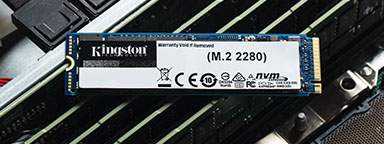
Should I Make the Switch to NVMe?
Cameron Crandall of Kingston helps you self-evaluate the need to move to your server storage solution to NVMe.
-
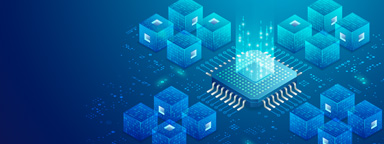
The NVMe Promise: Squeeze More Out of Existing CPUs
NVMe over Fabric helps CPUs to run more efficiently with lower latency and higher throughput.
-

Sustainability, Innovation, and Partnership Series - Episode 2
Join industry experts to discuss how technology partners like Kingston support their business growth and sustainability.
-

Sustainability, Innovation, and Partnership Series - Episode 1
Industry experts discuss topics like the key pillars of tech relationships, sustainability, and IT optimization.
-

Webinar: How Is NVMe Revolutionizing Storage?
Watch this webinar to discover the benefits of NVMe SSDs.
-

NVMe: Redundancy and RAID
The switch to NVMe requires a full stack review from IT architects to ensure redundancy exists on every layer of the stack.
-

Using AI to Turn Today’s Challenges into Tomorrow’s Opportunities
In this eBook, we talk to industry experts as we explore the benefits of artificial intelligence, how it’s fuelling data consumption and how you can prepare your organization for the opportunities it presents.
-

Driving NVMe Into the Future
Here are seven of the predictions of what will drive NVMe adoption for 2021.
-

How to Test an Enterprise SSD Part 2: Know Which Metrics to Test and Use the Right Software
Test SSDs to know the real endurance, changes in latency and IOPS in sequential and random read or write scenarios.
-
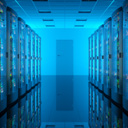
How to Test an Enterprise SSD Part 1: Use Your Exact Environment with Real Data, Apps, and Hardware
SSD test beds for enterprise servers should be done with the real hardware, OS and data. We’ll explain why.
-

Lockdowns, Upgrades, and Industry Challenges in the Cloud and Data Centers
MSP industry expert Rob May’s insight into how memory/storage upgrades help companies with remote workers.
-

Top 4 SSD Buying Mistakes
Don’t pick the wrong type of SSD for your server. A wrong choice means a higher cost of ownership. Learn to pick the right SSDs.
-

Influencer Tech Insights for 2021
What will 2021 bring in tech and trends? What do our KingstonCognate members and industry experts predict for the future?
-

Kingston SSDs are the best hardware choice for software-defined storage solutions
Learn why the future of business depends on SSD-enabled SDS, and how SSD fits into software-defined storage solutions.
-
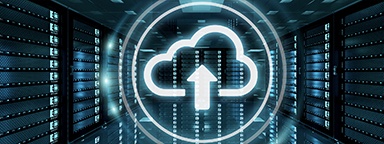
Case Study: Helping Rapid On-Premises Application Growth with Kingston Enterprise Products and Services
Learn how Hosteur supported their rapid growth & SLAs with Kingston Enterprise products & services.
-
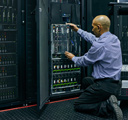
Rip and Replace vs Predictability: Why SSDs with Predictable Latency Matters
Data centers should be using server SSDs. There are many benefits over client drives and costs have come down.
-

The Benefits of NVMe in Enterprise
NVMe is now the standard protocol for SSDs to empower data centers and enterprise environments.
-

Case Study: Accelerating virtual machines with Kingston DC500M SSDs
Find out how Hardwareluxx were able to manage the growth of their web traffic using Kingston's DC500M SSD.
-

Is Now the Time for SDS (Software Defined Storage)?
SDS hasn’t lived up to its hype but now that NVMe is more affordable the commodity hardware is ready to deliver.
-

The Right Solid-State Drive (SSD) Matters
Choosing the right SSD for your server is important since server SSDs are optimized to perform at a predictable latency level while client (desktop/laptop) SSDs are not. These difference result in better uptime and less lag for critical apps and services.
-

Why does 5G need Edge Computing in a Micro Data Center?
Industry expert Simon Besteman provide insight on why 5G demands edge computing in micro data centers.
-
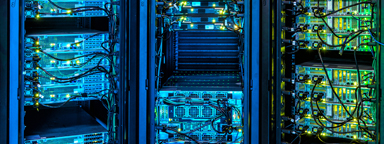
4 Things Data Center Managers Can Learn from HPC
Cloud and on-premise data center managers can learn a lot from supercomputing.
-
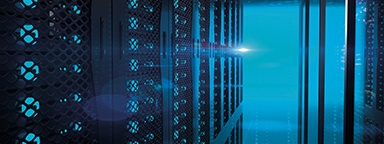
The Demand on Data Centers in the Time of Coronavirus
What are the demands of the Data Centers in these unprecedented times? Read this article from Industry Expert, Dr Sally Eaves & she will provide you with an insight on the demands.
-
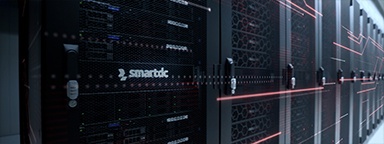
Kingston Memory & Enterprise SSDs Give Managed Hosting Provider i3D.net a Competitive Advantage
Kingston delivered compatible memory that met the performance goals of i3D.net's servers, extending the service life of their existing hardware.
-

The Future of Data Centers - 5G & Edge Computing
Why is Edge Computing Data Centers important for 5G? Download and read Kingston’s eBook on Edge Servers and the 5G rollout.
-

Improve SQL Server Performance with DC500M Enterprise SSDs
This whitepaper demonstrates how using Kingston Technology’s Data Centre DC500 SSDs can reduce your overall capital and licence costs by 39%.
-
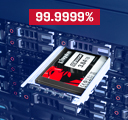
Quality of Service (QoS)
Data Center 500 Series SSDs (DC500R / DC500M) – Consistency, predictability of Latency (response time) and IOPS (I/Os Per Second) performance.
-

ECC and Spare Blocks help to keep Kingston SSD data protected from errors
End-to-End Data Protection protects customer’s data as soon as it is transferred by the host system to the SSD, and then from the SSD to the host computer. All Kingston SSDs incorporate this protection.
-

SSDs for Software-Defined Storage (SDS) Arrays
SDS provides a policy-based control of data tiers, independent of the underlying storage hardware.
-

SSD Over-provisioning (OP)
A percentage of space on an SSD is reserved for OP in firmware. OP can improve performance.
-
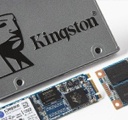
A Closer Look At SSD Power Loss Protection
Firmware/hardware PFAIL protection is an highly effective method for preventing data loss in enterprise SSD.
-

Kingston’s garbage collection methods allows greater SSD performance
Kingston uses LSI® SandForce®-based controllers in some SSDs that use proprietary tech for Garbage Collection.
-

SSDs for High-Performance Computing (HPC)
HPC can require massive amounts of data. SSDs consume a fraction of the power of their spinning disk.
-

SSDs for Online Transaction Processing (OLTP)
Kingston datacenter SSDs provide excellent resiliency to protect sensitive data in OLTP workloads.
-

FAQs for SATA and M.2 SSDs - Kingston Technology
Frequently asked questions around SSD technologies and terms like SATA, M.2, NAND, RAID, NVMe, PCIe, SAS, and keying.
-

SSDs for Virtual Desktop Infrastructure
Storage can be the most challenging component for VDI performance.
-
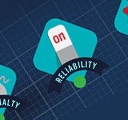
Solid-State Drive Testing 101
Testing is a cornerstone of our commitment to deliver the most reliable products on the market. We perform rigorous tests on all of our products during each stage of production. These tests ensure quality control throughout the entire manufacturing process.
-
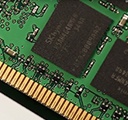
What is DDR4 Memory? Higher Performance
Learn how DDR4 delivers faster speeds, reduced power consumption and increased capacity over DDR3.





